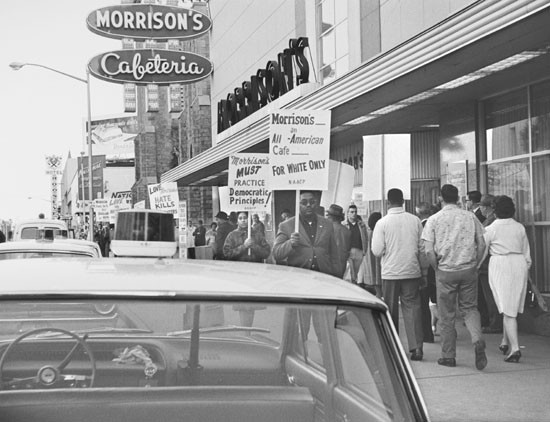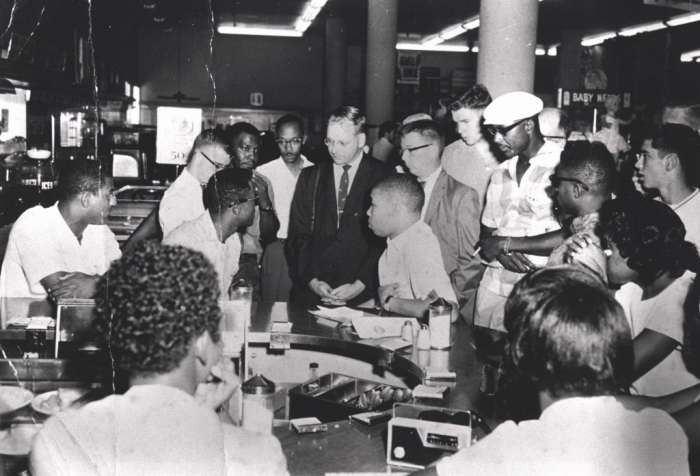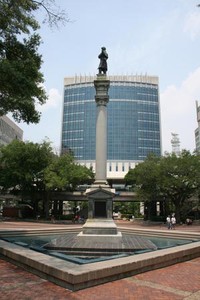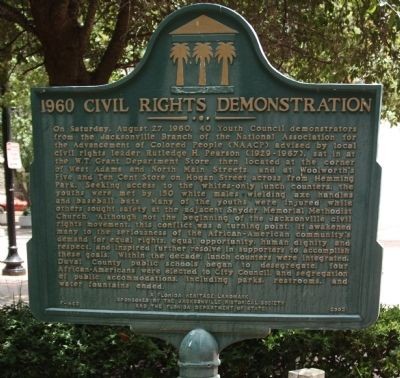1960 Civil Rights Demonstration Historic Marker (Axe Handle Saturday)
Introduction
Text-to-speech Audio
Images
Photo Credit: Courtesy The Florida Times-Union. "Morrison's Diner"

Photo Credit: Provided by Rodney Hurst: "Rodney Hurst (center right), who was 16 at the time, sits at the Woolworth's counter in August 1960. "

Photo Credit: Life Magazine Life magazine "A Jacksonville police officer helps a man identified as Charlie Griffin on Ax Handle Saturday."

Photo courtesty: http://jacksonville.about.com/ "Fountain at Hemming Plaza, Jacksonville, Florida"

Historic Landmarker for the Civil Rights Movement in Jacksonville, highlighting the significance of Axe Handle Saturday

Backstory and Context
Text-to-speech Audio
“Axe Handle Saturday” was the violent reaction to a series of nonviolent sit-in demonstrations in Jacksonville. Fourty members of the NAACP Youth Council conducted two sit-ins near this historical marker. The first sit-in was at W.T. Grant Department Store, and the other demonstration occurred at Woolworth’s Five and Ten Cent Store. The Youth Council protestors were met with opposition almost immediately, as white residents of the city surrounded the protesters and cursed them. Within minutes the white counter-protesters escalated their taunts, spitting on the youth and screaming violent threats.
White men soon arrived armed with bats, axe handles, and eventually police night sticks. Police ignored the mob and their violent threats until a Black street gang called “the Boomerangs” arrived and began defending the protestors. While the Black street gang attempted to shield the protesters, the white men began savagely beating African Americans whether they were part of the protest or simply in the vicinity. African American women and children were not spared. Eventually, those injured from the white mob were able to flee the scene and many took refuge inside Snyder Memorial Methodist Church. With police looking on many of the white assailants continued to patrol the streets in search of a Black person to attack.
While the protest and results were captured in Life magazine, the Jacksonville Times-Union and Jacksonville Journal were prohibited by city officials from documenting or reporting on the incident. It is also believed that the Ku Klux Klan may have been involved regarding the violence of Axe Handle Saturday. The police in the Deep South at the time were often accomplices to Klan violence as well.
Other civil rights demonstrations occurred in Jacksonville, but Axe Handle Saturday came to represent race relations in the city for many African Americans. Racial tensions had been building for decades prior to the demonstrations on that fateful August day, and unresolved issues and continued forms of structural racism continued well after the passage of the Civil Rights Act of 1964. This marker was dedicated long after the incident and is part of the city's gradual willingness to acknowledge its often troubled past. In 2012, Jacksonville elected their first African American mayor, fifty-two years after the brutal incident in Hemming Park.
Sources
Admin. “Florida Frontiers.” Florida Historical Society, 30 Oct. 2014, myfloridahistory.org/frontiers/article/32.
“Ax Handle Saturday, 1960: A Day of Defiance in Black and White.” Jacksonville.com, 19 Sept. 2011, jacksonville.com/2016-03-08/stub-299.Ax Handle Saturday, 1960: A Day of Defiance in Black and White," The Florida Times Union, accessed on September 30 2014
“Ax Handle Saturday: Violence in Hemming Plaza,” at ABOUT.COM, accessed on September 29, 2014
